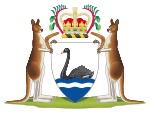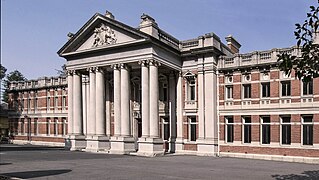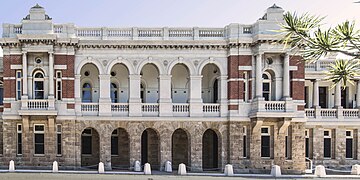Supreme Court of Western Australia: Difference between revisions
| Line 88: | Line 88: | ||
===Registrars=== |
===Registrars=== |
||
| ⚫ | |||
| ⚫ | |||
* Christopher Boyle |
* Christopher Boyle |
||
| ⚫ | |||
* Danielle Davies |
* Danielle Davies |
||
| ⚫ | |||
* June Eaton (Registrar Court of Appeal) |
* June Eaton (Registrar Court of Appeal) |
||
* Rainer Gilich |
* Rainer Gilich |
||
Revision as of 07:03, 9 January 2018
| Supreme Court of Western Australia | |
|---|---|
 | |
 Façade of the Supreme Court of Western Australia | |
 | |
| 31°57′27″S 115°51′36″E / 31.95754°S 115.859879°E | |
| Established | 1861 |
| Location | Perth |
| Coordinates | 31°57′27″S 115°51′36″E / 31.95754°S 115.859879°E |
| Composition method | Governor appointed by the recommendation of Cabinet. |
| Authorised by | Parliament of Western Australia via the Constitution Act 1889 (WA) and the Supreme Court Act 1935 (WA) |
| Appeals to | High Court of Australia |
| Judge term length | mandatory retirement by age of 70[1] |
| Number of positions | As many as necessary to deal with workload;[2] currently 21 judges |
| Website | www.supremecourt.wa.gov.au |
| Chief Justice of Western Australia | |
| Currently | Justice Wayne Martin |
| Since | 1 May 2006 |
The Supreme Court of Western Australia is the highest state court in the Australian State of Western Australia. It has unlimited jurisdiction within the state in civil matters (although it usually only hears matters involving sums of A$750,000 or more), and hears the most serious criminal matters.
Structure
The Supreme Court consists of a General Division (equivalent to the Trial Division in other states) and the Court of Appeal.
The General Division deals with serious criminal matters, civil cases where the amount claimed is greater than $750,000, criminal appeals from the Magistrates Court and appeals from other bodies such as the State Administrative Tribunal. The General Division sits in the David Malcolm Justice Centre for civil proceedings and the District Court of WA Building and the original Supreme Court Building for criminal proceedings.
The Court of Appeal hears both civil and criminal appeals from cases in the General Division, the District Court and the State Administrative Tribunal. It sits in the original Supreme Court Building.
When required, Supreme Court judges may also constitute the Industrial Appeal Court and sit as a Court of Disputed Returns.
The current Chief Justice of the Supreme Court is the Hon. Wayne Martin AC who was formally appointed to the position on 4 April 2006. Martin was appointed after a lengthy selection process which followed the retirement of David Malcolm on 7 February. Martin had been one of Western Australia's leading QC's before his appointment.
History
The Supreme Court was established in 1861 when the Court of Quarter Sessions (a criminal court for serious matters) and the Civil Court were amalgamated. Sir Archibald Burt was the first Chief Justice of the court.
The Full Court of the Supreme Court was established in 1886 to decide both criminal and civil appeals. In 1893 the criminal appeals were transferred to the Court of Appeal which was then reconstituted as the Court of Criminal Appeal in 1911.
The Supreme Court, Full Court and Court of Criminal Appeal were effectively the one court with each judge able to sit on cases in any of the courts.
In 2004 the Full Court and the Court of Criminal Appeal were subsumed by the Court of Appeal, which, while still a division of the Supreme Court, has judges which sit solely on appeal cases.
Judicial officers
The Supreme Court is currently constituted by the following judicial officers (in order of seniority):
Chief Justice
- Wayne Martin AC (1 May 2006)
President of the Court of Appeal
- Michael Buss (18 July 2016)
Judges of the Court of Appeal
- Robert Mazza (4 March 2010)
- Graeme Murphy (3 August 2010)
- Robert Mitchell (18 July 2016)
- Andrew Beech (24 May 2017)
Judges of the General Division
- Rene Le Miere (2 February 2004)
- Lindy Jenkins (2 February 2004)
- John Chaney (10 February 2009)
- Kenneth Martin (23 March 2009)
- Stephen Hall (6 July 2009)
- Michael Corboy (19 April 2010)
- Janine Pritchard (15 June 2010)
- Jeremy Allanson (9 August 2010)
- Jeremy Curthoys (10 February 2014) (President SAT)
- Peter Martino (20 April 2015)
- Paul Tottle (10 August 2015)
- Bruno Fiannaca (31 August 2015)
- Katrina Banks-Smith (18 July 2016)
- Joseph McGrath (28 November 2016)
- Gail Archer (29 May 2017)
Master
- Craig Sanderson
Principal Registrar
- Larissa Strk
Registrars
- Christopher Boyle
- Sandra Boyle
- Danielle Davies
- Simon Dixon
- June Eaton (Registrar Court of Appeal)
- Rainer Gilich
- Janet Whitbread
- Natalie Whitby
Supreme Court building
The Supreme Court building has considerable heritage significance in Western Australia. In 1899, a joint parliamentary committee was formed to decide on location of the new court building with three sites being considered.[3] The locations were a site in Irwin Street, the old Government Boys' School on St George's Terrace and the current site.[3] A decision was made and the contract awarded of £55,888 11s 3p to RP Vincent and Sons in February 1901 and an announcement was made to the public during March.[3] The foundation stone was laid on 2 June 1902 and would open on 8 June 1903 with WA Governor Sir Frederick Bedford present as was the Chief Justice Sir Edward Stone and the full court.[3]
The two-storey brick building was designed by John Harry Grainger (father of Percy Grainger), Chief Architect with the Public Works Department of Western Australia. It is designed in the Federation Academic Classical style: a style that was often used for major public buildings of the time. The original design called for only local materials to be used with Donnybrook stone, Meckering granite and jarrah wood the choice. Stuccoed cement had to be substituted when insufficient quantities of Donnybrook stone of identical texture and colour were lacking for the building.[3] Another change was the slate roof, when a galvanized roof was installed instead saving £5,425.[3] Originally, the grand foyer was to be painted in colours reflecting those of the glass domes, but again shortage of funds dictated the substitution of whitewash.[3] The foyer was more appropriately redecorated to celebrate the Court’s centenary in 2003.[4][3]
- Images of Supreme Court
-
Supreme Court, north front
-
Supreme Court, south front
-
Main Foyer
-
No 1 Court
David Malcolm Justice Centre
On 11 July 2016, the Supreme Court's Registry and General Division (Civil) relocated from the original Supreme Court Building to the new David Malcolm Justice Centre [5][6][7] located at 28 Barrack Street, Perth which is immediately north of the State Buildings complex.
-
Entrance to building
-
With Perth Town hall to the north
-
With State buildings to the south
See also
- Chief Justice of Western Australia
- List of Judges of the Supreme Court of Western Australia
- Judiciary of Australia
Notes
- ^ Judges' Retirement Act 1937 (WA) s 3
- ^ Supreme Court Act 1935 (WA) s 7A
- ^ a b c d e f g h "History of the Supreme Court of Western Australia" (PDF). Supreme Court of Western Australia. Retrieved 6 November 2016.
- ^ http://inherit.stateheritage.wa.gov.au/public
- ^ http://www.abc.net.au/news/2016-03-11/late-chief-justice-david-malcolm-honoured-name-court-building/7241300
- ^ https://www.cathedralsquare.com.au/businesses/mirvac-tower/ Mirvac Tower named the David Malcolm Justice Centre
- ^ https://www.finance.wa.gov.au/cms/News/Building_Management_and_Works/David_Malcolm_Justice_Centre_towers_over_Cathedral_Square.aspx
References
- "History". Supreme Court of Western Australia. 19 July 2012. Retrieved 31 August 2014.
- History of the Supreme Court of Western Australia (PDF), Supreme Court of Western Australia, 15 October 2008, retrieved 31 August 2014
Further reading
- State Archives of Western Australia. (1990) Bankruptcy records of the Supreme Court of Western Australia compiled by the State Archives of Western Australia.
(Alphabetical list of bankruptcy files held by the State Archives. Covers the period 1857–1928).








